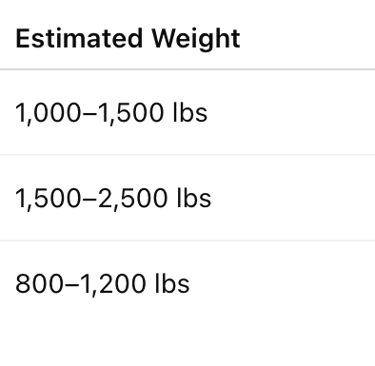Weight vs. Cubic Feet Moving Estimates
The total weight of your items determines weight-based estimates, while cubic feet estimates are based on their total volume. In reality, it doesn’t matter which kind of estimate you’re given. Instead, focus on finding a reputable mover.
4/9/20252 min read


Most trustworthy long-distance movers offer a binding estimate after doing a full inventory of your home. That means the final price is locked in based on the list of your household items—regardless of whether the estimate is based on weight or volume.
Still, knowing the difference between these two pricing methods can help you feel confident when comparing quotes.
Do Movers Charge by Weight or Volume?
Most professional movers charge by weight, not volume. Why? Because weight is easier to verify—especially by the U.S. Department of Transportation (USDOT), which adds an extra layer of accountability.
That said, the type of estimate isn’t as important as the fact that it’s binding. A binding estimate protects you from surprise charges later on.
Warning: Shady movers may overcharge, whether the quote is based on weight or volume. A good mover will explain what’s included in your quote, and clearly outline what could affect your final cost.
Understanding Weight-Based Estimates
With weight-based estimates, your cost is determined by the total weight of your belongings.
Here’s how it works:
The moving truck is weighed empty before loading.
It’s weighed again after it’s fully loaded.
The difference is the total weight of your shipment.
If there’s a dispute, you can request USDOT-certified weight tickets to verify the numbers. This method is preferred by most national van lines because it’s standardized, traceable, and fair.
What About Volume-Based (Cubic Feet) Estimates?
Volume-based estimates calculate cost based on the space your items occupy in the truck, measured in cubic feet (length × width × height).
While some reputable movers use this method, volume estimates are more vulnerable to manipulation. For example:
A mover might load the truck inefficiently, making your items appear to take up more space.
Measurements may be exaggerated to inflate the quote.
Still, cubic feet estimates are often used by moving container companies or DIY truck rentals, where understanding how much space you’ll need is key.
What Determines Your Moving Cost?
Regardless of whether the estimate is based on weight or volume, the most important factor is the inventory list—sometimes called a “Table of Measurements” or “Cube Sheet.”
This detailed list of your household goods is how your mover calculates the total cost. If you’re getting a binding estimate, be sure to review the inventory list carefully for accuracy.
Final Tip: Focus on the Estimate Type, Not Just the Method
Whether your quote is based on weight or cubic feet, the key is that it’s binding and based on an accurate inventory. That’s what protects you from surprise costs and ensures a smooth move.




5811 Kentland Ave., Woodland Hills, CA 91367
323.422.9988
info@ILlogisticsllc.com
LOS ANGELES
Copyright 2025 © All Rights Reserved.
Website Design by ActivPresence
AUSTIN
5900 Balcones Dr, Ste 100 Austin, TX 78731-4298
